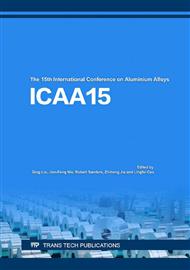p.251
p.258
p.264
p.275
p.281
p.290
p.296
p.303
p.310
Effects of Mn and Zr Addition in 6000 Series Aluminum Alloys on the Formation of Stabilized Substructures during Hot Deformation
Abstract:
Thermal stability of substructures in 6000 series aluminum alloys containing Mn and Zr elements was investigated using plane-strain compression test. In order to form thermally stabilized substructures, the deformation parameters should be selected so as to correlate with kinetic precipitation during the deformation. For substructures of the alloys containing Mn and Zr elements, the substructures were stable during the heat treatment at 540 ̊C when the alloys were deformed at a temperature above 350 ̊C. The sheets rolled above 350 ̊C at a strain rate of under 3 s-1 per pass showed the fibrous structure and well developed β-fiber textures after the heat treatment at 540 ̊C. The sheets with the fibrous structure had an average Lankford value larger than one.
Info:
Periodical:
Pages:
281-289
Citation:
Online since:
November 2016
Authors:
Price:
Сopyright:
© 2017 Trans Tech Publications Ltd. All Rights Reserved
Share:
Citation:


